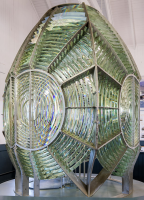








A Fresnel lens is a type of compact lens originally developed by French physicist Augustin-Jean Fresnel for lighthouses.
The design allows the construction of lenses of large aperture and short focal length without the mass and volume of material that would be required by a lens of conventional design. A Fresnel lens can be made much thinner than a comparable conventional lens, in some cases taking the form of a flat sheet. A Fresnel lens can capture more oblique light from a light source, thus allowing the light from a lighthouse equipped with one to be visible over greater distances.
History
The idea of creating a thinner, lighter lens by making it with separate sections mounted in a frame is often attributed to Georges-Louis Leclerc, Comte de Buffon.The marquis de Condorcet (1743–1794) proposed grinding such a lens from a single thin piece of glass.French physicist and engineer Augustin-Jean Fresnel is most often given credit for the development of the multi-part lens for use in lighthouses. According to Smithsonian magazine, the first Fresnel lens was used in 1823 in the Cordouan lighthouse at the mouth of the Gironde estuary; its light could be seen from more than 20 miles (32 km) out.Scottish physicist Sir David Brewster is credited with convincing the United Kingdom to adopt these lenses in their lighthouses.
The Fresnel lens reduces the amount of material required compared to a conventional lens by dividing the lens into a set of concentric annular sections. An ideal Fresnel lens would have infinitely many such sections. In each section, the overall thickness is decreased compared to an equivalent simple lens. This effectively divides the continuous surface of a standard lens into a set of surfaces of the same curvature, with stepwise discontinuities between them.
In some lenses, the curved surfaces are replaced with flat surfaces, with different angle in each section. Such a lens can be regarded as an array of prisms arranged in a circular fashion, with steeper prisms on the edges, and a flat or slightly convex center. In the first (and largest) Fresnel lenses, each section was actually a separate prism. 'Single-piece' Fresnel lenses were later produced, being used for automobile headlamps, brake, parking, and turn signal lenses, and so on. In modern times, computer-controlled milling equipment (CNC) might be used to manufacture more complex lenses.
Fresnel lens design allows a substantial reduction in thickness (and thus mass and volume of material), at the expense of reducing the imaging quality of the lens, which is why precise imaging applications such as photography still use conventional bulky lenses.
Fresnel lenses are usually made of glass or plastic; their size varies from large (old historical lighthouses, meter size) to medium (book-reading aids, OHP viewgraph projectors) to small (TLR/SLR camera screens, micro-optics). In many cases they are very thin and flat, almost flexible, with thicknesses in the 1 to 5 mm (0.039 to 0.197 in) range.